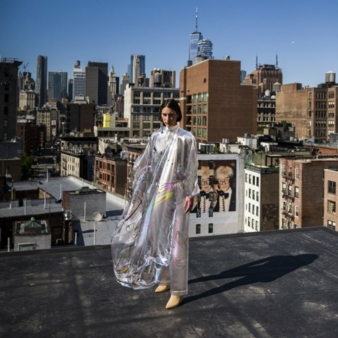30/04/2020 – Drive the Change – Air — auf Deutsch lesen
Data is in the air
“Scream of Joy!” – it was with this slogan that Zalando became known as a European pioneer of e-commerce.
These days, shopping from home has become par for the course. Last year, online traders in Germany posted almost EUR 19bn in clothing and footwear sales – up 11 percent on the year before. In a global comparison, the DACH countries have the fullest digital shopping carts, whilst Germany has the highest number of returns in the whole of Europe.
With free delivery and a 100-day returns policy, the German company Zalando set new service standards. Although its advertising slogan has changed, the vision has remained the same: to rethink the fashion market and take advantage of the potential offered by the fourth industrial revolution. Together with other visionaries, the company is shaping the digital future of the fashion industry.
Return reloaded
The sad truth: Half of all Zalando deliveries are returned. Looking at online clothing purchases throughout Germany, around 800,000 packages are sent back every day. This generates 400 tonnes of CO2 per day, which corresponds to 255 car journeys from Frankfurt to Beijing. In an attempt to minimise the environmental impact of their deliveries, Zalando joined forces with the Finnish start-up Repack in late 2019 and tested the application of reusable dispatch pouches. Extending the life cycle in this way can reduce CO2 emissions by up to 80 percent. However, for this concept to become scalable, the entire e-commerce sector would need to get involved. “By introducing multi-use packaging, the material is suddenly transformed from waste into a valuable material. A standardised system where customers don’t have to send the packaging back but can hand it in, for example, at their local supermarket, would make it far easier for everyone to adapt to the change,” commented Uwe Streiber, Team Warehouse Consumables at Zalando.
Until this time comes, Zalando is grabbing the problem by its root: “A third of returns are down to sizing,” stated Stacia Carr, Director of Engineering – Dedicated Owner Sizing at Zalando. Here too, the new technologies that made e-commerce happen in the first place, could prove helpful in solving this issue. Online shops are already doing their best to tackle this problem head-on by providing detailed product information, live chats and extensive image and video material. "Virtualisation gives us the opportunity to guide customers through a completely new purchasing process. It enables them to see how a product will look on their body shape before they press buy," stated Carr at the International Fashionsustain Conference, which was held at the sustainable fashion fair Neonyt. During the panel discussion “Virtually fashionable – and sustainable?”, she joined other industry experts in a lively discussion about the opportunities that digitalisation offers in creating a more environmentally friendly fashion industry. Facial recognition tests, two-dimensional image processing, 3D body scans: Using a variety of different processes over the past two years, Zalando has been testing how its 31 million customers could share their body measurements without even using a measuring tape. Encouragingly, 97% of the results matched the measurements of professional tailors. "If we can give consumers a quick and easy way of sharing their body measurements, it will change everything,” stated Carr.
The next step in e-commerce
Dr. Andreas Seidl, CEO of Human Solutions Group, was likewise on the panel of experts. In an effort to improve fit predictions in online shopping, the Human Solutions subsidiaries Assyst and Avalution are working on a research project which is due to conclude in July 2020. The software solution is based on Avalutions’ database of human body scans, which is the biggest in the world. The customer has to provide just four simple pieces of information for the program to assign them to a statistical avatar, which can perform a digital fit. The DITF Denkendorf is conducting a sustainability evaluation for the project. Before the order is completed, the customers are shown how their ordering habits affect the environment. This should enable consumers to understand that ordering several sizes to choose from, for example, results in higher returns and is, therefore, considerably worse for the environment.
“We want to create a completely new experience for online shoppers: We want to ensure that customers find the right product and the perfect fit much faster. At the same time, this will greatly reduce the hassle associated with returning goods whilst lessening the environmental impact – this would be an important step in the right direction for e-commerce,” commented Michael Stöhr, Director Business Unit Management Systems at Human Solutions Group. Companies like Zalando, Adidas and Vaude are already working with the software products from Assyst. In 2019, Assyst was presented with the Texprocess Innovation Award for its visionary use of 3D technology across the entire process – from creating to selling a garment.
Digital fashion on demand
“Are the products we’re manufacturing the right ones? We don’t know what our customers will want in twelve months’ time – that’s the problem. The ultimate objective would be to make only the products that customers need; to produce more on demand,” commented Dr. Andreas Seidl. Solutions that embrace intelligent and networked production were unveiled, for example, by the Neonyt Showcase exhibitor Lectra, featuring its Fashion on Demand product (textile network reported).
And what if the desired garment never actually has to be produced? Kerry Murphy, founder of the digital fashion house The Fabricant, states: “We’re the most sustainable fashion brand in the world – because we don’t actually make any physical clothing.” The homepage of the Dutch start-up claims: “We waste nothing but data and exploit nothing but our imagination.” The company’s digital-only concept is like glimpsing the future: Visitors to the website can download several outfits completely free of charge. In the next step, the garments can be fitted on a digital avatar and the animated videos can be posted on social media.
The idea?
First and foremost, it’s about being creative, about designing and sharing fashion with others without wasting resources. Influencers, for example, will often buy the latest clothes, wear them once for a photo and then never again. By contrast, virtual garments can be shared for peer group confirmation without wasting precious resources. The vision behind the idea is that only clothing that is genuinely liked to the point of wanting to own it, is actually bought “on demand” – it is hoped that customers will learn to choose their physical clothing much more thoughtfully, and that they will wear it for longer – and that the clothing itself is made to a higher standard of quality.
Is a digital T-shirt more sustainable per se? Yes, it is! In collaboration with the Fashion-For-Good Accelerator, The Fabricant examined the aspect of environmental impact. They found that the carbon footprint of the digital garment was, in fact, ten times smaller than its physical counterpart.
The digital fashion industry is already much closer than we would generally think.
For example, the in-game store operated by the free online game Fortnite generates a million dollars in sales every day; almost 60 percent of all purchases are outfits for virtual identities. Such a development could easily spread to channels such as Instagram and LinkedIn. “This is the missing link: At the moment, if we don’t send out a package, people can’t try on and share an outfit and they can’t get confirmation from their peers,” commented Stacia Carr during the Fashionsustain panel discussion in January. “I really hope that the opportunity to experience fashion in a virtual context will change what we buy in the physical world. I hope we’ll start having a greater appreciation for products that last and that fashion that can only be disposed of digitally becomes a playground of creativity again.”
Lena M. Kaufmann




